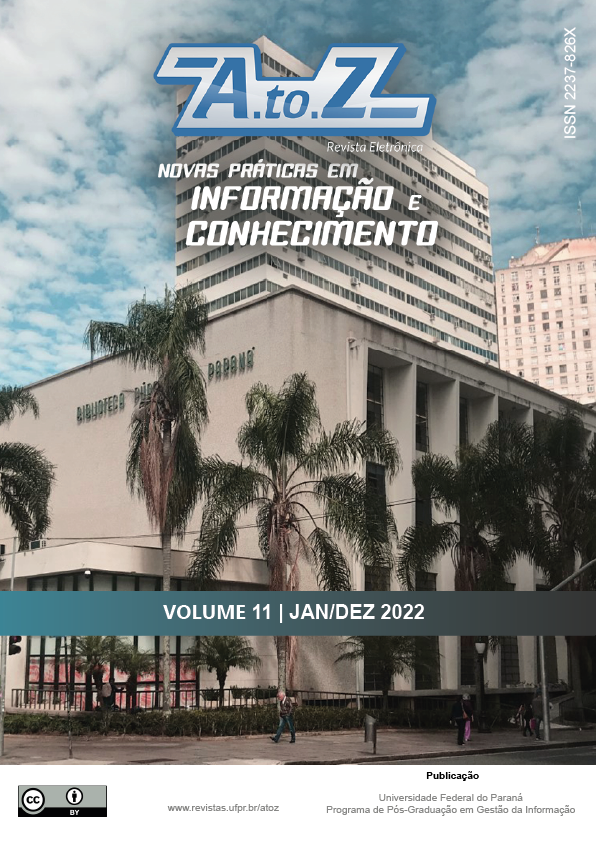Tourist tracking and monitoring: a study of the technologies used
DOI:
https://doi.org/10.5380/atoz.v11i0.79927Keywords:
Tourist tracking and counting, Information technology, Smart tourist destination, Tourism.Abstract
Introduction: Introduction: Tourism is an element that has a significant contribution to the development and renovation of cities and according to the Paraná Turístico 2026 plan a new approach to smart destinations on the temporal and spatial behavior of tourists using new technologies for tracking or counting can serve as a key factor in improving the sustainable management of tourism. Following this trend, this study seeks to carry out a systematic review of the literature on the topic of tourist movement, aiming to classify the most used. Method: Systematic literature review, analyzing scientific publications in ACM, IEEE, Science Direct and Scopus journals databases in the last 5 years. Results: 761 articles were found, of which 47 were selected for reading and data extraction, and then the most cited technologies in the literature were classified and generated, where the technologies used in each article are presented. Topics such as: technologies for tracking and counting tourists, smart tourism, information technology, management and sustainability are highlighted in the surveys. Conclusion: The present study served to answer the question; “What are the most used technologies for tracking tourists?”, thus, it can be said that the objective of this study was achieved by classifying the 5 main technologies most used being: GPS, Applications, Sensors, Social Media and RFID followed by others of equal relevance for further studies. It was found that the technologies raised, mostly, are free technologies, in which it is possible to develop innovative projects with low execution cost.
References
Aditya, T., & Laksono, D. (2017). LOD 1: 3D CityModel for Implementing SmartCity Concept. In Proceedings of the 2017 International Conference on Information Technology (pp. 136–141). New York, NY, USA: Association for Computing Machinery. Retrieved from https://doi.org/10.1145/3176653.3176734
Albusaidi, H. S., Udupi, P. K., & Dattana, V. (2016). Integrated data analytic tourism dashboard (IDATD). In 2016 5th International Conference on Reliability, Infocom Technologies and Optimization (Trends and Future Directions) (ICRITO) (pp. 497–500). Retrieved from https://doi.org/10.1109/ICRITO.2016.7785006
Aranburu Amiano, I., Plaza Inchausti, B., & Esteban Galarza, M. (2020). Identification of central urban attractions based on GPS tracking data and network analysis [Identificación de atracciones urbanas centrales mediante seguimiento GPS y análisis de redes]. Boletin de La Asociacion de Geografos Espanoles, (84). Retrieved from https://doi.org/10.21138/bage.2840
Aranburu, I., Plaza, B., & Esteban, M. (2016). Sustainable cultural tourism in urban destinations: Does space matter? Sustainability (Switzerland), 8(8). Retrieved from https://doi.org/10.3390/su8080699
Arreeras, T., Arimura, M., Asada, T., & Arreeras, S. (2019). Association rule mining tourist-attractive destinations for the sustainable development of a large tourism area in Hokkaido using Wi-Fi tracking data. Sustainability (Switzerland), 11(14). Retrieved from https://doi.org/10.3390/su11143967
Barros, C., Moya-Gómez, B., & García-Palomares, J. C. (2019). Identifying temporal patterns of visitors to national parks through geotagged photographs. Sustainability (Switzerland), 11(24). Retrieved from https://doi.org/10.3390/su11246983
Basori, A. H., Abdul Hamid, A. L. Bin, Firdausiah Mansur, A. B., & Yusof, N. (2019). IMars: Intelligent Municipality Augmented Reality Service for Efficient Information Dissemination based on Deep Learning algorithm in Smart City of Jeddah. Procedia Computer Science, 163, 93–108. Retrieved from https://doi.org/10.1016/j.procs.2019.12.091
Brovelli, M. A., Minghini, M., & Zamboni, G. (2016). Public participation in GIS via mobile applications. ISPRS Journal of Photogrammetry and Remote Sensing, 114, 306–315. Retrieved from https://doi.org/10.1016/j.isprsjprs.2015.04.002
Caldeira, A., & Kastenholz, E. (2014). Comportamento espácio-temporal do turista urbano: o impacte da duração da estada. Revista Turismo & Desenvolvimento, 2(21), 111–121.
Cantis, S. De, Ferrante, M., Kahani, A., & Shoval, N. (n.d.). Cruise passengers’ behavior at the destination: Investigation using {GPS} technology, 52, 133–150. Retrieved from https://doi.org/https://doi.org/10.1016/j.tourman.2015.06.018
CEPATUR, C. P. de T. (2016). Paraná Turístico 2026: pacto para um destino inteligente. Retrieved from http://www.turismo.pr.gov.br/arquivos/File/institucional/PLANO_DE_TURISMO/ParanaTuristico2026documentocompleto__1.pdf
Chen, K.-Y., & Yang, S.-Y. (2019). A cloud information monitoring and recommendation multi-agent system with friendly interfaces for tourism. Applied Sciences (Switzerland), 9(20). Retrieved from https://doi.org/10.3390/app9204385
Crivellari, A., & Beinat, E. (2019). Identifying foreign tourists’ nationality from mobility traces via LSTM neural network and location embeddings. Applied Sciences (Switzerland), 9(14). Retrieved from https://doi.org/10.3390/app9142861
Dâmaso, Lí. (2019). O que é app? Quatro perguntas e respostas sobre aplicativos para celular | Apps | TechTudo. Retrieved 15 January 2021, from https://www.techtudo.com.br/noticias/2019/12/o-que-e-app-quatro-perguntas-e-respostas-sobre-aplicativos-para-celular.ghtml
Dionísio, R. P. (2016). Cidades e territórios inteligentes: um desafio emergente. Revista Do Instituto Politécnico de Castelo Branco, 9(1647–9335), 14–21. Retrieved 16 September 2020 from https://doi.org/10400.11/6013
Domènech, A., Gutiérrez, A., & Anton Clavé, S. (2020). Built environment and urban cruise tourists’ mobility. Annals of Tourism Research, 81(December 2018), 102889. Retrieved from https://doi.org/10.1016/j.annals.2020.102889
East, D., Osborne, P., Kemp, S., & Woodfine, T. (2017). Combining GPS & survey data improves understanding of visitor behaviour. Tourism Management, 61, 307–320. Retrieved from https://doi.org/10.1016/j.tourman.2017.02.021
Encalada, L., Boavida-Portugal, I., Ferreira, C. C., & Rocha, J. (2017). Identifying tourist places of interest based on digital imprints: Towards a sustainable smart City. Sustainability (Switzerland), 9(12). Retrieved from https://doi.org/10.3390/su9122317
Frajberg, D., Fraternali, P., Torres, R. N., Bernaschina, C., & Fedorov, R. (2019). A testing framework for multi-sensor mobile applications. Journal of Mobile Multimedia, 15(1–2), 1–28. Retrieved from https://doi.org/10.13052/jmm1550-4646.15121
Fukuzaki, A., Koide, N., & Sonehara, N. (2017). Poster: TTPP method for validation of K-anonymity on Wi-Fi association log data. In Proceedings of the 10th ACM Conference on Security and Privacy in Wireless and Mobile Networks, WiSec 2017 (pp. 275–276). New York, NY, USA: Association for Computing Machinery. Retrieved from https://doi.org/10.1145/3098243.3106021
Gcaba, O., & Dlodlo, N. (2016). The internet of things for South African tourism. In 2016 IST-Africa Week Conference (pp. 1–8). Retrieved from https://doi.org/10.1109/ISTAFRICA.2016.7530573
Gogoni, R. (2020). O que é GPS? | Aplicativos e Software | Tecnoblog. Retrieved 15 January 2021, from https://tecnoblog.net/312677/o-que-e-gps/
Gu, W., Jin, M., Zhou, Z., Spanos, C. J., & Zhang, L. (2016). MetroEye: Smart Tracking Your Metro Trips Underground. In Proceedings of the 13th International Conference on Mobile and Ubiquitous Systems: Computing, Networking and Services (pp. 84–93). New York, NY, USA: Association for Computing Machinery. Retrieved from https://doi.org/10.1145/2994374.2994381
Han, S., Ren, F., Wu, C., Chen, Y., Du, Q., & Ye, X. (2018). Using the tensor flow deep neural network to classify mainland China visitor behaviours in Hong Kong from check-in data. ISPRS International Journal of Geo-Information, 7(4). Retrieved from https://doi.org/10.3390/ijgi7040158
Hardy, A., Birenboim, A., & Wells, M. (2020). Using geoinformatics to assess tourist dispersal at the state level. Annals of Tourism Research, 82(August 2019), 102903. Retrieved from https://doi.org/10.1016/j.annals.2020.102903
Huamantinco Cisneros, M. A., Revollo Sarmiento, N. V., Delrieux, C. A., Piccolo, M. C., & Perillo, G. M. E. (2016). Beach carrying capacity assessment through image processing tools for coastal management. Ocean and Coastal Management, 130, 138–147. Retrieved from https://doi.org/10.1016/j.ocecoaman.2016.06.010
Kaplan, A. M., & Haenlein, M. (2010). Users of the world, unite! The challenges and opportunities of Social Media. Business Horizons, 53(1), 59–68. Retrieved from https://doi.org/10.1016/j.bushor.2009.09.003
Kong, D., Li, X., & Zhang, B. (2019). Design and Implementation of VR Multi-Dimensional Intelligent Tourism Information System. Journal of Physics: Conference Series, 1237(4). Retrieved from https://doi.org/10.1088/1742-6596/1237/4/042041
Kulshrestha, T., Niyogi, R., Misra, M., & Patel, D. (2017). Smart pilgrim: A mobile-sensor-cloud based system to safeguard pilgrims through smart environment. In 2017 Tenth International Conference on Contemporary Computing (IC3) (pp. 1–6). Retrieved from https://doi.org/10.1109/IC3.2017.8284304
Kurniawan, D. E., Dzikri, A., Suriya, M., Rokhayati, Y., & Najmurrokhman, A. (2018). Object Visualization Using Maps Marker Based On Augmented Reality. In 2018 International Conference on Applied Engineering (ICAE) (pp. 1–5). Retrieved from https://doi.org/10.1109/INCAE.2018.8579411
Law, R., Buhalis, D., & Cobanoglu, C. (2014). Progress on information and communication technologies in hospitality and tourism. International Journal of Contemporary Hospitality Management, 26(5), 727–750. Retrieved from https://doi.org/10.1108/IJCHM-08-2013-0367
Lin, Y. (2020). Automatic recognition of image of abnormal situation in scenic spots based on Internet of things. Image and Vision Computing, 96, 103908. Retrieved from https://doi.org/10.1016/j.imavis.2020.103908
Miller, A. B., Leung, Y. F., & Kays, R. (2017). Coupling visitor and wildlife monitoring in protected areas using camera traps. Journal of Outdoor Recreation and Tourism, 17, 44–53. Retrieved from https://doi.org/10.1016/j.jort.2016.09.007
Millhäusler, A., Anderwald, P., Haeni, M., & Haller, R. M. (2016). Publicity, economics and weather – Changes in visitor numbers to a European National Park over 8 years. Journal of Outdoor Recreation and Tourism, 16, 50–57. Retrieved from https://doi.org/10.1016/j.jort.2016.09.005
Neuhofer, B., & Buhalis, D. (2014). Technology enhanced tourism experience. Retrieved from https://www.researchgate.net/publication/272566581_Technology_enhanced_tourism_experience
Nozhenkov, A., & Korobko, A. (2020). Technologies and applications for the support of tourism in Krasnoyarsk region. IOP Conference Series: Materials Science and Engineering, 862(5). Retrieved from https://doi.org/10.1088/1757-899X/862/5/052066
Nunes, N., Ribeiro, M., Prandi, C., & Nisi, V. (2017). Beanstalk: A Community Based Passive Wi-Fi Tracking System for Analysing Tourism Dynamics. In Proceedings of the ACM SIGCHI Symposium on Engineering Interactive Computing Systems (pp. 93–98). New York, NY, USA: Association for Computing Machinery. Retrieved from https://doi.org/10.1145/3102113.3102142
Paiva, M. F. de. (2020). Identificação por rádio frequência de acordo com a norma técnica | Revista Analytica. Retrieved 15 January 2021, from https://revistaanalytica.com.br/identificacao-por-radio-frequencia-de-acordo-com-a-norma-tecnica/
Periyasamy, M., Karthikeyan, S., & Mahendran, G. (2019). Selected studies of sediment tracking in mixed and gravel beaches using RFID technology - A review. Materials Today: Proceedings, 33(xxxx), 4003–4006. Retrieved from https://doi.org/10.1016/j.matpr.2020.06.342
Raun, J., Ahas, R., & Tiru, M. (2016). Measuring tourism destinations using mobile tracking data. Tourism Management, 57, 202–212. Retrieved from https://doi.org/10.1016/j.tourman.2016.06.006
Rogowski, M. (2020). Monitoring System of tourist traffic (MSTT) for tourists monitoring in mid-mountain national park, SW Poland. Journal of Mountain Science, 17(8), 2035–2047. Retrieved from https://doi.org/10.1007/s11629-019-5965-y
Salas-Olmedo, M. H., Moya-Gómez, B., García-Palomares, J. C., & Gutiérrez, J. (2018). Tourists’ digital footprint in cities: Comparing Big Data sources. Tourism Management, 66, 13–25. Retrieved from https://doi.org/10.1016/j.tourman.2017.11.001
Sanmiquel, L., Alfonso, P., Bascompta, M., Vintró, C., Parcerisa, D., & Oliva, J. (2018). Analysis of the European tourist mines and caves to design a monitoring system [Análisis de las cuevas y minas turísticas de Europa para diseñar un sistema de monitorización]. DYNA (Colombia), 85(205), 249–255. Retrieved from https://doi.org/10.15446/dyna.v85n205.69701
Santiago, M. L., González, I. S., Gil, C. C., Gil, P. C., & Priano, F. H. (2018). Novel guidance CPS based on the FatBeacon protocol. Applied Sciences (Switzerland), 8(4). Retrieved from https://doi.org/10.3390/app8040647
Shoval, N., Kahani, A., De Cantis, S., & Ferrante, M. (2020). Impact of incentives on tourist activity in space-time. Annals of Tourism Research, 80. Retrieved from https://doi.org/10.1016/j.annals.2019.102846
Silveira, C. B. (2020). O que são sensores e quais as suas aplicações? - Mundo da Elétrica. Retrieved 15 January 2021, from https://www.mundodaeletrica.com.br/o-que-sao-sensores-e-quais-as-suas-aplicacoes/
Sood, R. (2017). Intelligent mobile based tourist assistance system. In 2017 2nd International Conference for Convergence in Technology (I2CT) (pp. 655–658). Retrieved from https://doi.org/10.1109/I2CT.2017.8226211
Specht, C., Dabrowski, P. S., Pawelski, J., Specht, M., & Szot, T. (2019). Comparative analysis of positioning accuracy of GNSS receivers of Samsung Galaxy smartphones in marine dynamic measurements. Advances in Space Research, 63(9), 3018–3028. Retrieved from https://doi.org/10.1016/j.asr.2018.05.019
Střelák, D., Škola, F., & Liarokapis, F. (2016). Examining User Experiences in a Mobile Augmented Reality Tourist Guide. In Proceedings of the 9th ACM International Conference on PErvasive Technologies Related to Assistive Environments (pp. 1–8). New York, NY, USA: ACM. Retrieved from https://doi.org/10.1145/2910674.2935835
Su, H., Lin, X., Xie, Q., Chen, W., & Tang, Y. (2018). Research on the Construction of Tourism Information Sharing Service Platform and the Collection of Tourist Satisfaction. In 2018 3rd International Conference on Smart City and Systems Engineering (ICSCSE) (pp. 640–643). Retrieved from https://doi.org/10.1109/ICSCSE.2018.00137
Sugimoto, K., Ota, K., & Suzuki, S. (2019). Visitor mobility and spatial structure in a local urban tourism destination: GPS tracking and network analysis. Sustainability (Switzerland), 11(3). Retrieved from https://doi.org/10.3390/su11030919
Švajda, J., Masný, M., Koróny, S., Mezei, A., Machar, I. V. O., & Taczanowska, K. (2018). Visitor profiling using characteristics of socio-demographic and spatial behavior as tools to support the management of protected mountain areas. Geografie-Sbornik CGS, 123(4), 461–478. Retrieved from https://doi.org/10.37040/geografie2018123040461
Taczanowska, K., Bielański, M., González, L. M., Garcia-Massó, X., & Toca-Herrera, J. L. (2017). Analyzing spatial behavior of backcountry skiers in mountain protected areas combining GPS tracking and graph theory. Symmetry, 9(12), 1–15. Retrieved from https://doi.org/10.3390/sym9120317
Teles da Mota, V., & Pickering, C. (2020). Using social media to assess nature-based tourism: Current research and future trends. Journal of Outdoor Recreation and Tourism, 30. Retrieved from https://doi.org/10.1016/j.jort.2020.100295
Thimm, T., & Seepold, R. (2016). Past, present and future of tourist tracking. Journal of Tourism Futures, 2(1), 43–55. Retrieved from https://doi.org/10.1108/JTF-10-2015-0045
Tranfield, D., Denyer, D., & Smart, P. (2003). Towards a methodology for developing evidence-informed management knowledge by means of systematic review. British Journal of Management, 14(3), 207–222.
Wikipédia. (2020). Mídias sociais – Wikipédia, a enciclopédia livre. Retrieved 15 January 2021, from https://pt.wikipedia.org/wiki/Mídias_sociais
Zejda, D., & Zelenka, J. (2019). The concept of comprehensive tracking software to support sustainable tourism in protected areas. Sustainability (Switzerland), 11(15). Retrieved from https://doi.org/10.3390/su11154104
Zubiaga, M., Izkara, J. L., Gandini, A., Alonso, I., & Saralegui, U. (2019). Towards smarter management of overtourism in historic centres through visitor-flow monitoring. Sustainability (Switzerland), 11(24). Retrieved from https://doi.org/10.3390/SU11247254
Downloads
Published
How to Cite
Issue
Section
License
Atoz is a open access journal and the authors have permission and are encouraged to deposit their papers in personal web pages, institutional repositories or portals before (pre-print) or after (post-print) the publication at AtoZ. It is just asked, when and where possible, the mention, as a bibliographic reference (including the atributted URL), to the AtoZ Journal.
The authors license the AtoZ for the solely purpose of disseminate the published work (peer reviewed version/post-print) in aggregation, curation and indexing systems.
The AtoZ is a Diadorim/IBICT green academic journal.
All the journal content (including instructions, editorial policies and templates) - except where otherwise indicated - is under a Creative Commons Attribution 4.0 International, since October 2020.
When published by this journal, articles are free to share (copy and redistribute the material in any support or format for any purpose, even commercial) and adapt (remix, transform, and create from the material for any purpose , even if commercial). You must give appropriate credit , provide a link to the license, and indicate if changes were made
AtoZ does not apply any charges regarding manuscripts submission/processing and papers publication.



























